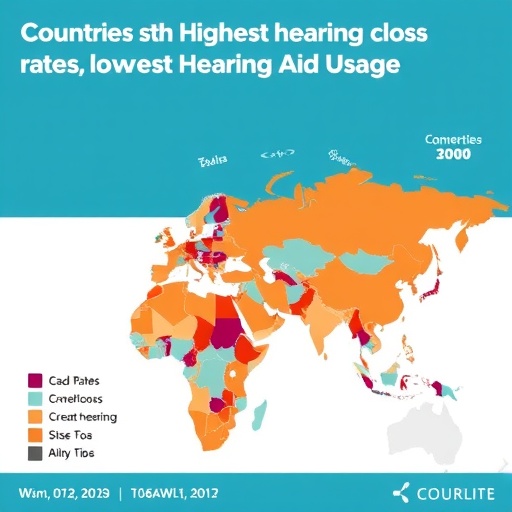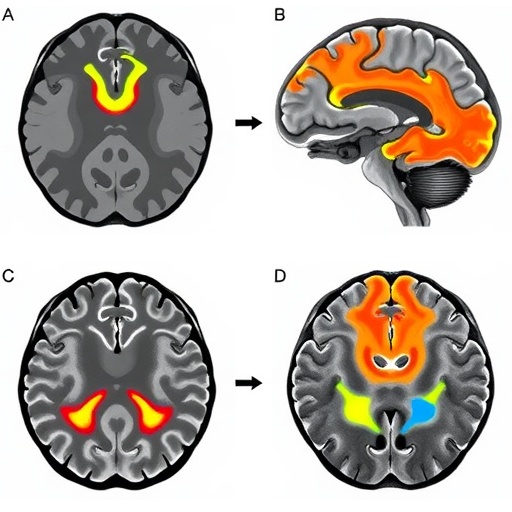A groundbreaking international study recently published in BMJ Global Health reveals a striking paradox in the global landscape of hearing loss and hearing aid usage. Researchers uncovered that countries reporting the highest prevalence of hearing loss paradoxically display the lowest rates of hearing aid adoption, highlighting a critical gap in auditory healthcare access worldwide. This comprehensive analysis delves into self-reported hearing loss and hearing aid utilization across diverse nations and sheds light on gender disparities and age-related trends that could shape future public health initiatives.
Hearing loss currently affects an estimated 1.57 billion people globally, approximately one in five individuals, and experts predict this number will surge to 2.45 billion by 2050. This widespread sensory impairment has far-reaching consequences beyond just diminished auditory capacity. Studies have linked hearing loss in adults to increased risks of depression, social isolation, loneliness, and cognitive decline. Furthermore, it exacerbates the likelihood of falls, postoperative complications, cardiovascular ailments, and even premature mortality, positioning hearing loss as a significant public health challenge.
Despite its prevalence and impact, precise measurement of hearing loss remains hindered by several factors, chiefly the scarcity of audiological services and the high costs associated with objective auditory testing. To circumvent these limitations, the research team employed self-reported data on hearing ability and hearing aid use collected from eight nationally representative longitudinal studies involving 28 countries, spanning two decades of data from 2001 to 2021. While subjective, this methodology allowed unprecedented insight into hearing health patterns across diverse socioeconomic and cultural landscapes.
These eight landmark studies included large-scale cohorts from Brazil, China, Costa Rica, Mexico, South Africa, South Korea, the United States, and numerous European countries. Collectively, these datasets provided nuanced information on participants’ demographic, socioeconomic, behavioral, and health characteristics, primarily focusing on adults in their sixties and beyond. Hearing loss was operationally defined by individuals self-rating their hearing as fair or poor, or reporting consistent hearing aid use, creating a composite marker for auditory impairment.
The findings reveal stark international disparities. China reported the highest prevalence of hearing loss at approximately 65%, a figure alarmingly high for a condition affecting sensory function. In contrast, South Africa’s prevalence was notably lower, at just 16.5%. Paradoxically, hearing aid usage inversely correlated with hearing loss rates. Countries with the greatest hearing loss prevalence like China, South Korea, Mexico, and Brazil showed dismally low hearing aid use, between 1% and 6%. Meanwhile, regions such as Northern Europe, Western Europe, and the United States exhibited significantly higher hearing aid adoption rates, with up to 39% of individuals with hearing loss using aids.
Age emerged as a fundamental factor influencing both hearing loss prevalence and aid adoption. While hearing deterioration predictably increased with advancing age in all nations, patterns of hearing device usage varied significantly. In Northern Europe, for example, hearing aid uptake rose steadily and markedly with age—from approximately 13% usage among 50- to 54-year-old men with hearing loss, scaling upwards to 74% among men aged 85 and above. Similar though less pronounced trends were observed in other parts of Europe, Brazil, and South Korea, albeit starting from lower baselines.
Conversely, South Africa presented an unusual age-related trend, where older adults were less likely to report hearing aid use compared to their younger counterparts. This counterintuitive pattern may reflect structural barriers within healthcare infrastructure or cultural attitudes toward disability and device adoption, warranting further investigation. Such regional anomalies underscore the complexity of hearing health dynamics shaped by social, economic, and systemic factors.
Gender disparities also played a compelling role in auditory health outcomes. Men were consistently more likely than women to report hearing loss in nearly all countries studied, except China, South Korea, and South Africa, where this gap narrowed or was virtually nonexistent. The largest gender divergence appeared in the United States, where men were 1.6 times more likely than women to report hearing difficulties. Intriguingly, the gender gap diminished with advancing age, indicating potential biological, environmental, or behavioral influences interacting over the lifespan.
When it came to hearing aid use, gender patterns mirrored broader geographic trends. In regions with high adoption rates such as Northern Europe, USA, Western Europe, and Israel, younger women tended to use hearing aids more frequently than their male peers. However, in countries with low overall use—particularly China, South Korea, and South Africa—men outpaced women in hearing device adoption across nearly all age groups, despite the overall low uptake. Brazil presented a notable exception where women were more likely than men to utilize hearing aids, challenging some established assumptions about gender and health technology engagement.
This study, however, is not without limitations. Reliance on self-reported hearing loss and hearing aid use introduces potential biases related to subjective perception, social desirability, and cultural stigma. The focus on upper-middle to high-income nations may limit the generalizability of findings to low-income countries, where healthcare resources and audiological services are even less accessible. Nonetheless, the robust cross-national scope and longitudinal design offer valuable insights into the multifaceted challenges surrounding auditory health globally.
Researchers emphasize the importance of understanding the interplay between structural healthcare systems and cultural beliefs in shaping hearing health outcomes. Countries with underdeveloped audiology services and pervasive stigma around disability may experience compounded barriers to hearing aid access and acceptance. Even in high-coverage insurance environments like Western and Northern Europe, hearing aid uptake rarely approaches full saturation, suggesting that financial coverage, while necessary, is insufficient on its own to drive widespread device use.
The findings advocate for multifaceted strategies to address hearing loss worldwide. Enhancing audiology service availability, reducing stigma, tailoring interventions to gender- and age-specific needs, and fostering inclusive healthcare policies emerge as critical priorities. Given the projected rise in global hearing impairment, targeted efforts could mitigate the profound individual and societal burdens of untreated hearing loss.
In sum, this international comparative study elucidates a critical and often overlooked health disparity: the gulf between hearing loss prevalence and hearing aid utilization. By charting demographic, socioeconomic, and cultural contours of auditory health, the research advances our understanding of global hearing loss patterns and lays the groundwork for informed policy interventions aimed at closing this gap. As the world’s population ages and sensory impairments escalate, addressing this silent epidemic becomes an urgent imperative for public health systems worldwide.
Subject of Research: People
Article Title: Gender differences in self-reported hearing loss and hearing aid use: a cross-national comparison
News Publication Date: 2-Oct-2025
Web References:
https://doi.org/10.1136/bmjgh-2024-017655
Keywords: Hearing loss, Hearing aids





